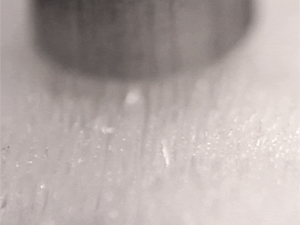



Date:21/06/16
 At this year’s ACM CHI, a team of researchers at Massachusetts Institute of Technology (MIT) presented, what is perhaps, one of the most peculiar (but groundbreaking) technologies developed in 3D printing thus far: Printing densely packed, artificial programmable hair.
At this year’s ACM CHI, a team of researchers at Massachusetts Institute of Technology (MIT) presented, what is perhaps, one of the most peculiar (but groundbreaking) technologies developed in 3D printing thus far: Printing densely packed, artificial programmable hair.
And at just 50 microns in width (one micron is 1×10−6 of a metre), some of its more serious applications include functioning like cilia.
If you aren’t aware, cilia are extremely small hair-like organelles found on the surface of mammalian cells and organs. They’re responsible for certain functions in your body that you might not actually be aware of, but are rather necessary all the same (they do things like keep your lung airways clear and allow our eyes to function properly so we aren’t all blind). And with this in mind, the team is calling this technology Cilllia.
The team behind Cilllia is from MIT’s Tangible Media Group, and their project is a bitmap-generating program that creates these ultra-fine hair-like structures instead of modelling hair strands individually through other software. A bitmap is a type of memory organization, or image file format, that is used to store digital images.
Since the generated model is a bitmap, these files are 3D printer-ready, meaning you just run the software, set the precise characteristics of the hair, and then print. Impressive as this already is, the resulting artificial hair has a host of other fascinating applications.
While there are a number of potential aesthetic purposes, customized paint brushes or strong adhesive surfaces might be at the top of people’s lists on what 3D printed hair could be used for.
Moreover, by applying vibration to the hair, it causes them to do interesting things like move objects in a certain pattern, like conveyor belts…without the belts (kind of how cilia function in some instances). And by controlling the characteristics of the hairs and matching them with specific vibrations, the researchers have developed gearless motors. They even made figurines that can “dance” to music.
And just like sensory cilia, the artificial hair could also pave the way to new tactile sensors. Thanks to the sensitive nature of the hair’s structure, the researchers simply placed a patch over a microphone, and it can sense how you touch it. These are just some of the applications.
MIT researchers create 3D-printed fur, opening up ‘a new design space’
 At this year’s ACM CHI, a team of researchers at Massachusetts Institute of Technology (MIT) presented, what is perhaps, one of the most peculiar (but groundbreaking) technologies developed in 3D printing thus far: Printing densely packed, artificial programmable hair.
At this year’s ACM CHI, a team of researchers at Massachusetts Institute of Technology (MIT) presented, what is perhaps, one of the most peculiar (but groundbreaking) technologies developed in 3D printing thus far: Printing densely packed, artificial programmable hair.And at just 50 microns in width (one micron is 1×10−6 of a metre), some of its more serious applications include functioning like cilia.
If you aren’t aware, cilia are extremely small hair-like organelles found on the surface of mammalian cells and organs. They’re responsible for certain functions in your body that you might not actually be aware of, but are rather necessary all the same (they do things like keep your lung airways clear and allow our eyes to function properly so we aren’t all blind). And with this in mind, the team is calling this technology Cilllia.
The team behind Cilllia is from MIT’s Tangible Media Group, and their project is a bitmap-generating program that creates these ultra-fine hair-like structures instead of modelling hair strands individually through other software. A bitmap is a type of memory organization, or image file format, that is used to store digital images.
Since the generated model is a bitmap, these files are 3D printer-ready, meaning you just run the software, set the precise characteristics of the hair, and then print. Impressive as this already is, the resulting artificial hair has a host of other fascinating applications.
While there are a number of potential aesthetic purposes, customized paint brushes or strong adhesive surfaces might be at the top of people’s lists on what 3D printed hair could be used for.
Moreover, by applying vibration to the hair, it causes them to do interesting things like move objects in a certain pattern, like conveyor belts…without the belts (kind of how cilia function in some instances). And by controlling the characteristics of the hairs and matching them with specific vibrations, the researchers have developed gearless motors. They even made figurines that can “dance” to music.
And just like sensory cilia, the artificial hair could also pave the way to new tactile sensors. Thanks to the sensitive nature of the hair’s structure, the researchers simply placed a patch over a microphone, and it can sense how you touch it. These are just some of the applications.
Views: 584
©ictnews.az. All rights reserved.Similar news
- The mobile sector continues its lead
- Facebook counted 600 million active users
- Cell phone testing laboratory is planned to be built in Azerbaijan
- Tablets and riders outfitted quickly with 3G/4G modems
- The number of digital TV channels will double to 24 units
- Tax proposal in China gets massive online feedback
- Malaysia to implement biometric system at all entry points
- Korea to build Green Technology Centre
- Cisco Poised to Help China Keep an Eye on Its Citizens
- 3G speed in Azerbaijan is higher than in UK
- Government of Canada Announces Investment in Green Innovation for Canada
- Electric cars in Azerbaijan
- Dominican Republic Govt Issues Cashless Benefits
- Spain raises €1.65bn from spectrum auction
- Camden Council boosts mobile security





















